Silicon Valley August Market Data


We are committed to continuing to serve all your real estate needs while incorporating safety protocol to protect all of our loved ones.
In addition, as your local real estate experts, we feel it’s our duty to give you, our valued client, all the information you need to better understand our local real estate market. Whether you’re buying or selling, we want to make sure you have the best, most pertinent information, so we’ve put together this monthly analysis breaking down specifics about the market.
As we all navigate this together, please don’t hesitate to reach out to us with any questions or concerns. We’re here to support you.
– Maya Sewald & Jason Sewald, DRE #00993290 / 01732384
Welcome to our August newsletter. This month, we take a look at the conditions of the U.S. and global economies in relation to the local, state, and national real estate markets. In particular, we examine some crucial economic indicators, Real Gross Domestic Product (GDP) and the unemployment rate. Although COVID-19 is still surging through California and the country, sellers are returning to the market, bringing some much-needed supply to meet buyer demand. As we make our way through the summer months, we continue to provide you with the most up-to-date market information so that you feel supported and informed in your buying and selling decisions.
In this month’s newsletter, we cover the following:
Key News and Trends in August
The National Bureau of Economic Research officially deemed February 2020 the most recent U.S. economic peak ending the decade-long expansionary economic cycle, which means we are in a recession until we begin another growth cycle. Unlike the last recession between 2007 and 2009, which was heavily tied to the housing market, the current COVID-induced recession is less likely to affect the housing market, at least in the short-term.
During the second quarter of 2020, home prices rose nationally while GDP—the broadest measure of goods and services produced—dropped 9.5% quarter-over-quarter. GDP and the housing market usually trend together over time. The connection between the two is quite simple: overall personal income should rise as GDP increases, thereby accumulating enough wealth to purchase a home.
Because demand for housing still outpaces supply, the negative GDP figure will likely not significantly impact housing unless it persists through the next year. Perhaps the more pertinent news regarding GDP is that the federal government offset the drop in production and spending through COVID-19 relief and stimulus measures. Specifically, the recipients of the $600 per week federal unemployment supplement, which ended July 31, largely infused that money back into the economy.
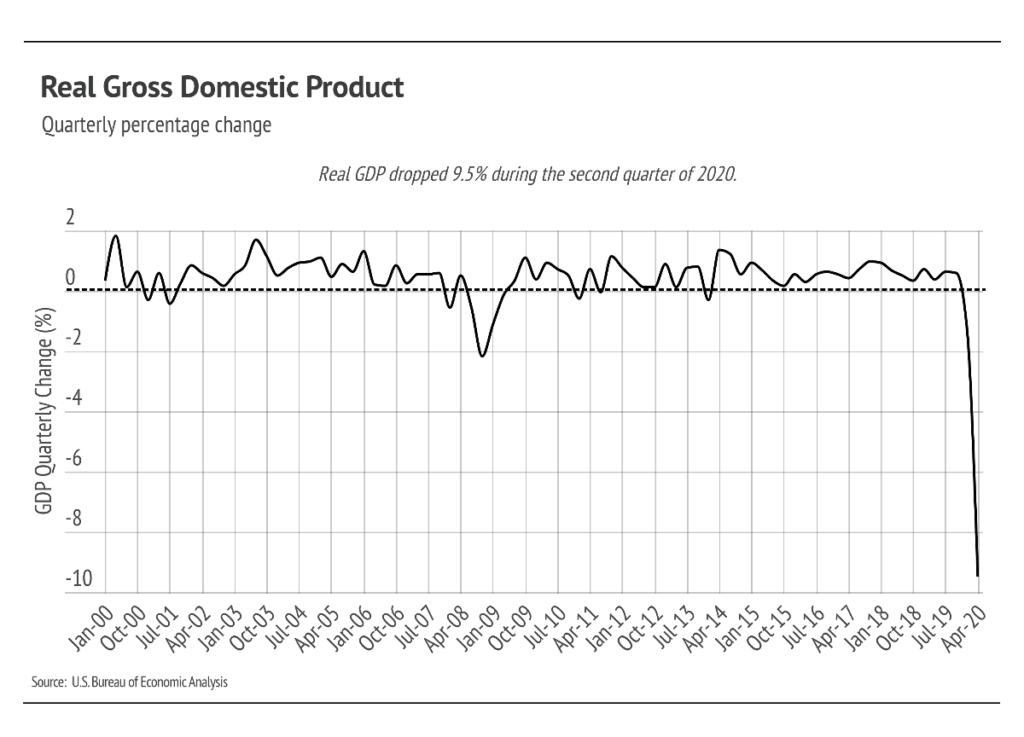
The number of continued unemployment claims, those that continue collecting unemployment after their initial claim, has not dropped as precipitously as was hoped. As mentioned in previous newsletters, the initial projections for when the virus would be under control was mid-July, which did not come to pass. As the United States navigates its way through its pandemic response, 16 million unemployed workers continue to collect unemployment benefits. Economists estimate that the actual number of unemployed workers is around 25 million.
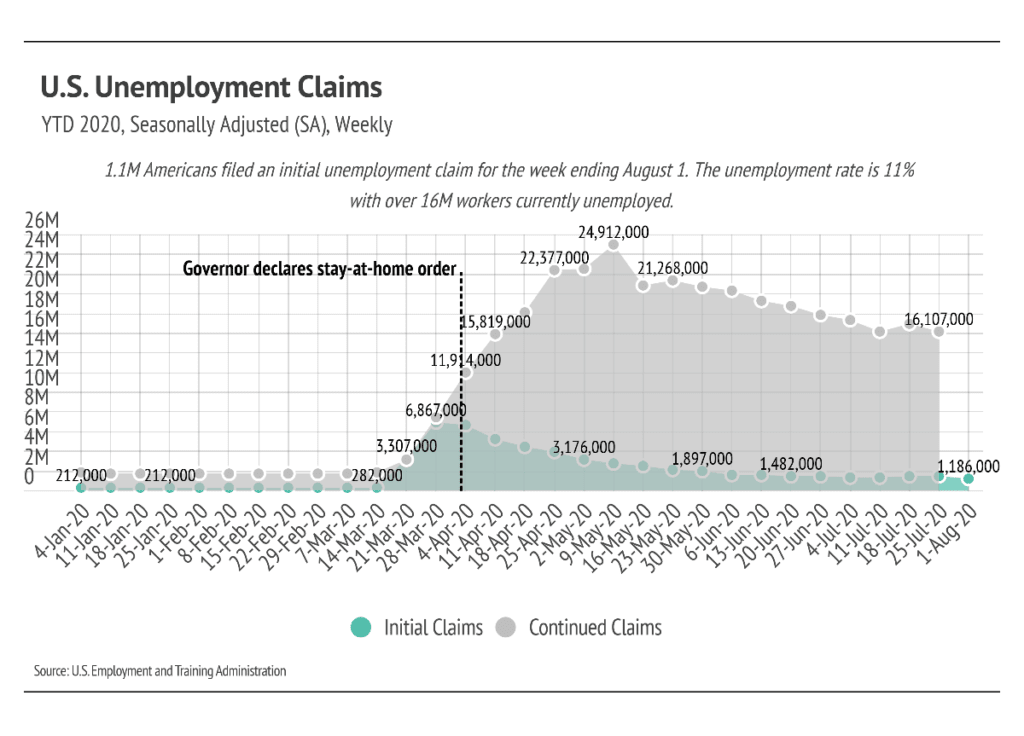
Unemployment claims continue to cause some of the biggest concerns about the overall economy. If people continue to collect unemployment rather than going back to work, those cases will turn into permanent, rather than temporary, job losses. Moreover, many businesses face permanent closure as time passes, which permanently reduces the total number of jobs available.
Fewer jobs amid already high unemployment rates could lead to a long road to economic recovery and evictions. In the short-term, rental properties may experience a squeeze in profits. As we continue to monitor the market, we will look for unusual upticks in rental properties coming to market, suggesting this trend is underway.
On the other hand, the pandemic has left many with more money than usual as their personal spending has dropped considerably. Those interested and able to buy a home are in the lowest interest rate environment in history. Freddie Mac reports that the interest rate on a 30-year fixed mortgage is at 2.88%. This is the first time the rate has dropped below 3%.
As we have discussed in previous newsletters, the affordability of a home increases (or decreases) significantly with each percentage of interest. A mortgage loan for a $1.2 million home at the January 2020 rate of 3.72% costs $555 per month more than a loan at 2.88%, amounting to $200,000 over the life of the loan. As a result, we have seen a boom in refinancing, which we expect to continue for homeowners who do not wish to move. For buyers (or refinancers), this could be the lowest interest rate they will experience in their lifetime and an excellent time to execute the purchase of a home.
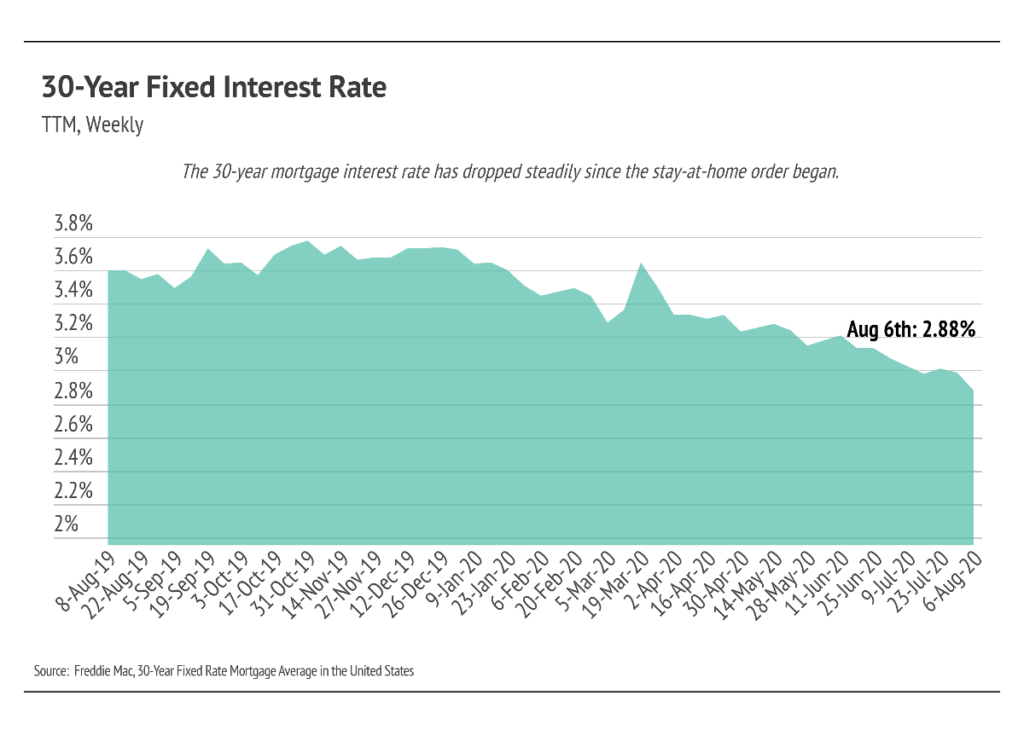
August Housing Market Updates for Silicon Valley
A note on the data: We utilize data from the California Association of Realtors®, which provides an incredibly rich data set. In an effort to bring you these reports in a timely manner, for the month of August, we are using June’s numbers to analyze market trends over the first half of the year.
Single-family home prices climbed higher in all counties. The condo market was a bit more mixed with decreasing year-over-year median prices in San Mateo and Santa Clara.
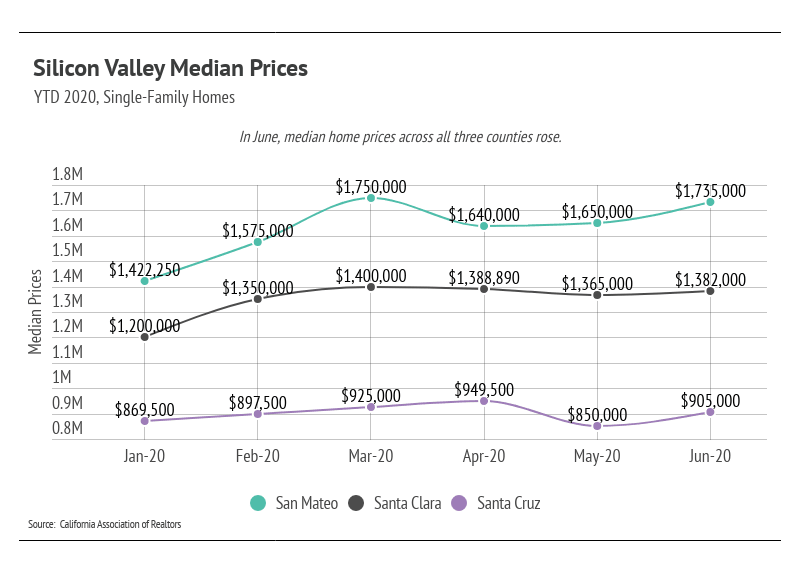
Year-over-year, single-family home prices in San Mateo had the largest gains while Santa Clara and Santa Cruz were flat. The Silicon Valley market as a whole has fared well throughout the pandemic with year-over-year prices dipping briefly in April and May for single-family homes.
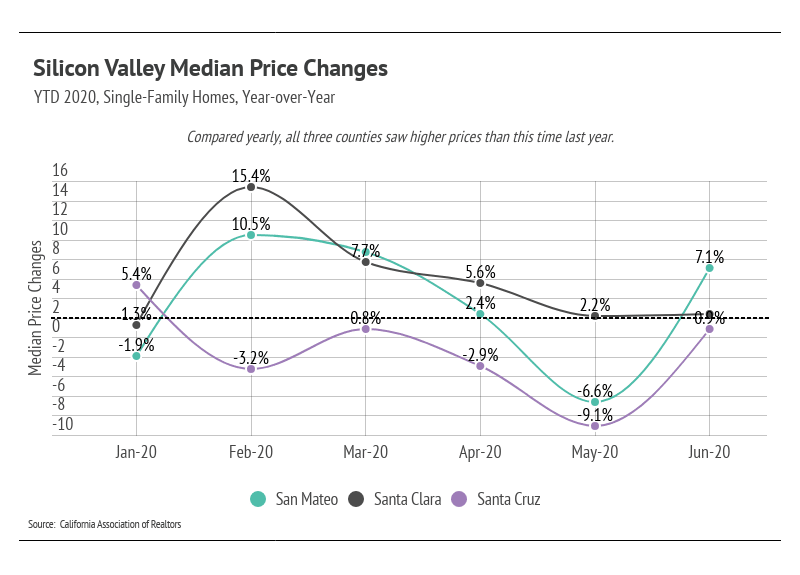
As we dive deeper into the county data, we see that single-family homes in all counties posted gains year-over-year. Median condo prices posted mixed results. As we continue to spend more time indoors, we are not surprised by the higher demand for single-family homes with larger space.
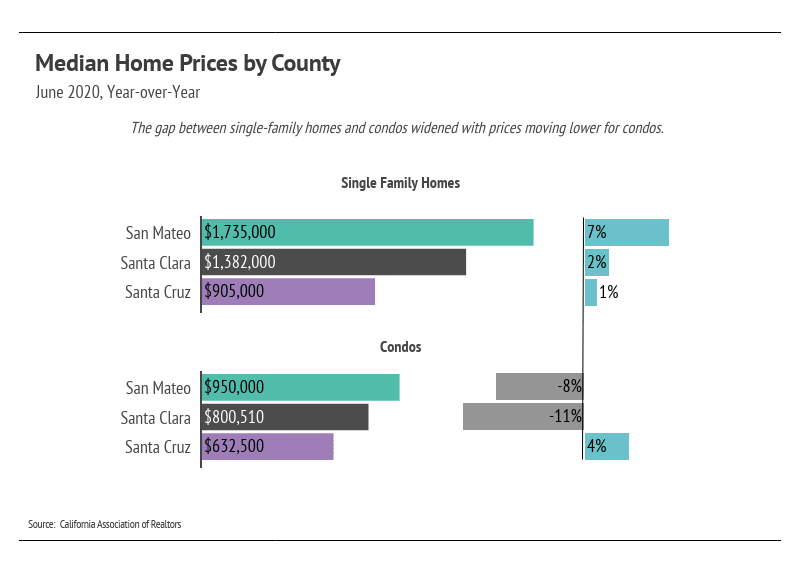
Active inventory of homes for sale increased to the highest levels this year and has since decreased slightly since. With demand high and supply close to flat, we expect the year-over-year median price changes to continue its upward trend. Silicon Valley’s prices tend to be buoyed by lack of supply compared to demand, which still remains true. We believe that the current supply of 3,758 homes for sale allows markets to run efficiently. Buyers have plenty of options to find what they actually want, leading to more sales.
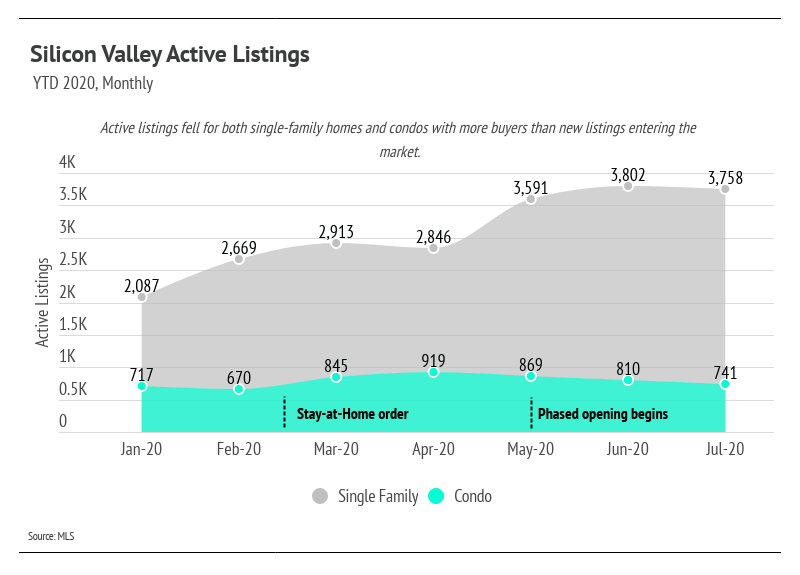
We can look to Months of Supply Inventory (MSI)—the measure of how many months it would take for all current homes for sale on the market to sell at the current rate of sales—as a proxy for demand. MSI has an average of three months in California. An MSI lower than three means that buyers are dominating the market and there are relatively few sellers; a higher MSI means there are more sellers than buyers. The MSI for single-family homes fell below the three-month mark in all three counties and now favors sellers once again.
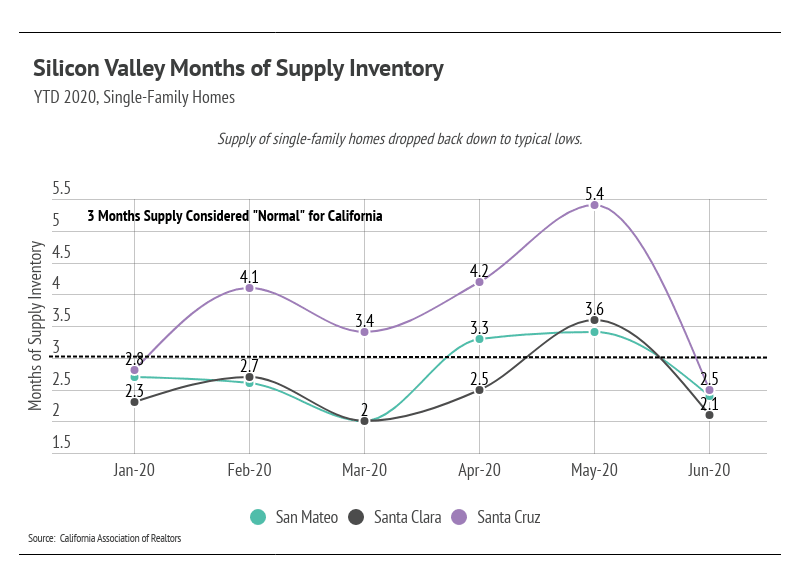
Year-over-year, the San Mateo condo market had a significant increase in MSI and inched over the three-month mark.
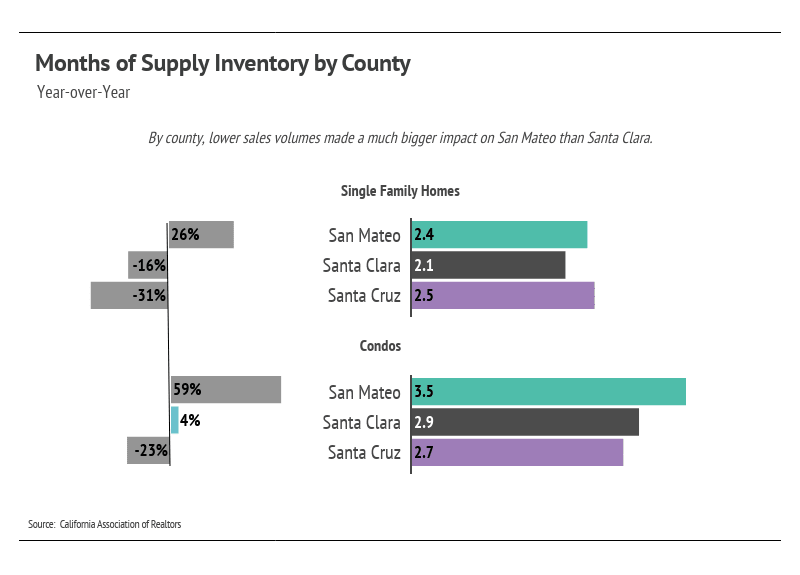
The number of single-family homes under contract continued to trend upward, which contributed to the falling MSI and highlights the demand in Silicon Valley. Based on these metrics, we believe the housing market is thriving.
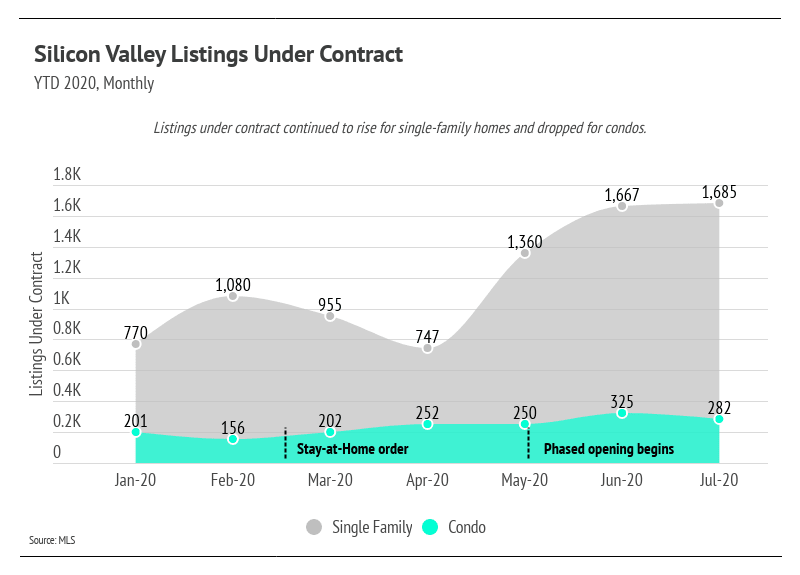
We can also analyze home sales—the result of homes under contract that close within 30 days—on a monthly basis, while also comparing them to last year’s numbers. Sales are still down in San Mateo and Santa Cruz year-over-year for single-family homes but are on an upward path. Silicon Valley experienced large month-over-month gains, which is a remarkable recovery from the May low.
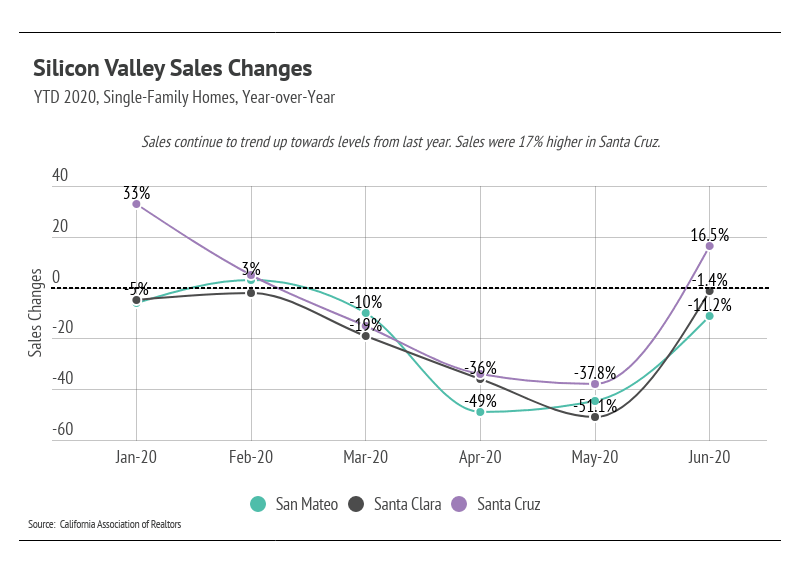
Sale-to-list ratios—which compare the prices buyers pay to the listed prices of homes—suggest that buyers are not paying large premiums. The chart below illustrates the price that the average Silicon Valley buyer negotiated to put a property under contract, and whether or not it was above or below list price. Both single-family homes and condos sold in-line with original list prices. Single-family home and condo buyers can expect to pay around the listed price.
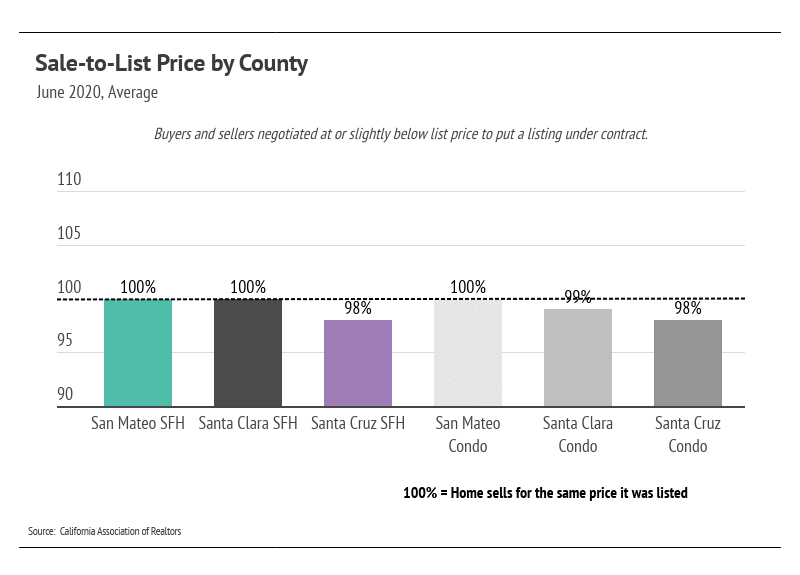
In summary, the difficulty that the housing market experienced in March through May, as evidenced by sales volume and supply, has subsided. The housing market has shown its resilience through the pandemic and remains one of the safest asset classes. Whether you are buying or selling a home, it is still incredibly important to seek out the advice of real estate experts.
Moving forward, we anticipate more sellers coming to market. The initial seller reticence caused by COVID-19 seems to have subsided. As more supply becomes available, there could be a small price correction in the market, but we do not believe that will occur during the summer months while demand is so high.
As always, we remain committed to helping our clients achieve their current and future real estate goals. Our team of experienced professionals are happy to discuss the information we have shared in this newsletter. We welcome you to contact us with any questions about the current market or to request an evaluation of your home or condo.


Seasonality in the housing market was incredibly steady before the pandemic. Prices typically rose from January to June, when inventory was low but rising, and then fl… Read more

The driving force behind the substantial price increases over the past two years has been the supply of homes, or lack thereof. So, will the housing shortage reverse? … Read more

As your local real estate experts, we feel it’s our duty to give you, our valued client, all the information you need to better understand our local real estate market… Read more

Happy early Thanksgiving! Please read below our market update for the month of November. In addition, as your local real estate experts, we feel it’s our duty to give … Read more

Welcome to our October newsletter, where we’ll explore residential real estate trends in Silicon Valley and across the nation. This month, we examine the state of the … Read more

During this time of the year, we are starting to enter the Fall market. The market is still very strong with limited inventory in our local markets. Strong sales are s… Read more

Welcome to our August newsletter, where we’ll explore residential real estate trends in Silicon Valley and across the nation. This month, we examine the state of the U… Read more

As your local real estate experts, we feel it’s our duty to give you, our valued client, all the information you need to better understand our local real estate market… Read more
You’ve got questions and we can’t wait to answer them.